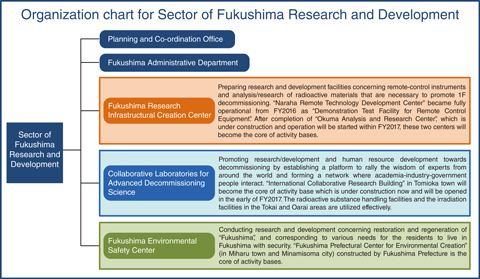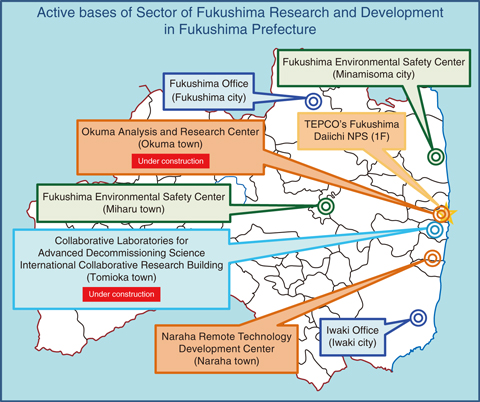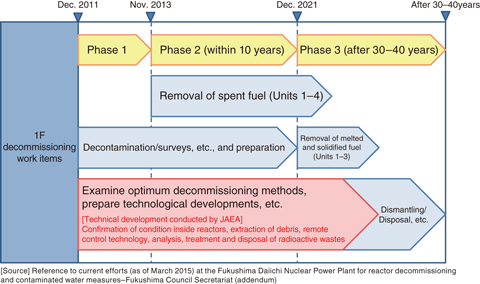
Fig.1-1 Organization of Sector of Fukushima Research and Development (as of October 2016)

Fig.1-2 Location of activity bases related to the Sector of Fukushima Research and Development in Fukushima Prefecture (as of October 2016)

Fig.1-3 Outline of the roadmap for 1F-decommissioning work
Core organization and activity bases for R&D related to the accident at the TEPCO’s Fukushima Daiichi NPS (1F)
As a public institution created by the Basic Act on Disaster Control Measures after The Great East Japan Earthquake in March 11, 2011, we have conducted R&D related to the accident at 1F and responded to various actions such as radiation measurement. These activities have been presented in annual reports published from 2012 to 2015. In the 2015 report, we noted that we had organized a Sector of Fukushima Research and Development as a core organization related to 1F (Fig.1-1) and that activity bases were being developed. Such bases are taking shape as of 2016 (Fig.1-2).
Development of essential R&D bases to promote the decommissioning of 1F
The Fukushima Research Infrastructural Creation Center is establishing two essential R&D bases to promote the decommissioning of 1F. These bases will assume roles in the preparation for removal of fuel debris from nuclear reactors and in the treatment and disposal of radioactive wastes generated by the decommissioning work.
The first facility for R&D is the Naraha Remote Technology Development Center in Naraha town. The Research-management Building and Mock-up Test Building were completed in September 2015 and February 2016, respectively, and the center became fully operational in FY2016. The second facility for R&D is the Okuma Analysis and Research Center in Okuma town, which is now under construction.
The Naraha Remote Technology Development Center serves primarily to promote the decommissioning of 1F based on the Mid-and-Long-Term Roadmap (Fig.1-3) formulated by the Inter-Ministerial Council for Contaminated Water and Decommissioning Issues as well as improvement of science and technology to support the decommissioning, enhancement of the safety base, and community symbiosis. To promote the decommissioning of 1F, we have developed a virtual-reality system that simulates work-area conditions in 1F; this system will be used to check work plans prior to commencing operation and to train workers and operators of remote-controlled equipment to study work plans and secure worker safety.
The Okuma Analysis and Research Center conducts analysis and research of radioactive materials generated from 1F, such as radioactive waste and debris samples obtained after the removal of fuel debris from nuclear reactors. The design of this facility proceeds based on such policies as the Technical Strategic Plan formulated by the NDF and the operation schedule outlined in the Mid-and-Long-Term Roadmap. Construction of the Administrative Building for the main facilities (which consist of the Administrative Building, Laboratory-1, and Laboratory-2) started in FY2016. This building will commence operation in FY2017.
Establishment of a platform for rallying the wisdom of experts from around the world to promote the development of an R&D base for accelerating decommissioning work and addressing challenges
The Collaborative Laboratory for Advanced Decommissioning Science (CLADS) was established as an R&D center for decommissioning reactors in the Tokai area in April 2015. To accelerate this decommissioning research, experts must share their understanding of current requirements and anticipated future problems and R&D must be enhanced from basic to practical use. CLADS forms an interacting human resource network of universities, research institutions, and industries at home and abroad to meet the R&D challenge related to decommissioning reactors and promote human resource development by industry, academia and government. The International Collaborative Research Building (tentative name) is under construction in Tomioka town in Fukushima Prefecture as a base institute for gathering the wisdom of experts from home and abroad; it will be completed by the end of FY2016 and will be opened in the early part of FY2017.
Regarding experiment and research using actual nuclear and radioactive materials, we conduct R&D at handling and irradiation facilities in the Tokai and Oarai areas. CLADS has achieved various research results; we have devised an approach for predicting the melt progression of nuclear-fuel debris (an amorphous mixed oxide consisting of melted and hardened material from both the nuclear fuel in the reactor-pressure vessel (RPV) and the core structure) using a simulation model (Topic 1-1); and we are analyzing the concentration of each element under segregation and distribution of nuclear and core-structural material in nuclear fuel debris from outside of the RPV using laser-induced breakdown spectroscopy (Topic 1-2).
Beginning in FY2017, we will conduct collaborative research and information exchanges with universities, research institutes, and industries at home and abroad, utilizing our own facilities, with the International Collaborative Research Building (in Tomioka town) constituting a core component. In the mid- and long-term, we are also promoting research on decommissioning 1F based on policies such as the Technical Strategic Plan; this is done in accordance with the on-site requirements and in cooperation with the Fukushima Prefecture, the International Research Institute for Nuclear Decommissioning (IRID), and the NDF.
R&D related to the decommissioning of 1F based on our knowledge and technical skill
We are Japan’s sole comprehensive R&D institute in the field of nuclear energy and we have knowledge and technical skill in various subjects. Annual R&D results on the decommissioning of 1F based on such knowledge and technical skill are presented.
We have developed a cutting technique based on remote operation of a plasma jet, and confirmed this technique’s utility in flooded vessels and output enhancement that enables to cut and crush thickly aggregated ceramics (such as nuclear-fuel debris) (Topic 1-3).
We have conducted simulation assessment using supercomputers to elucidate the core-melting procedure in severe accidents and developed a technique for calculating the possible melt-relocation behavior that may occur in actual accidents (Topic 1-4).
In order to clarify the mechanism of radioactive cesium (Cs) deposition onto the RPV structural material, we have determined that radioactive Cs may form chemical compounds by interaction with not only silicon but also iron in the carbon steel; our results suggest that once deposited, radioactive Cs can re-vaporize when its temperature rises (Topic 1-5).
Evaluation of the soundness of containers used to stably preserve the spent radioactive Cs removed from the contaminated water of 1F showed that adsorption vessels containing zeolite decreased the possibility of localized corrosion occurring during long-term storage (Topic 1-6).
Pyrochemical-reprocessing technologies is usually used as a reprocessing technology of the spent fuel in the reprocessing plant. We studied the applicability of this technology to a candidate treatment method for the 1F. Through this study, new (improved) chlorination method was developed. We developed a new chlorination method as a pretreatment technology. The entire quantity of uranium (U) was successfully converted into uranium tetrachloride (UCl4) and separated by distillation at a lower temperature than before. We confirmed that this method is applicable for processing the nuclear-fuel debris in principle (Topic 1-7).
Preparation of R&D-activity bases related to environmental recovery in Fukushima
To proceed with the activities outlined in the Basic Guidelines for Fukushima Reconstruction and Revitalization (Cabinet Decision, July 2012) and the Fukushima Prefecture Center for Environmental Creation Policy for Medium- and Long-term Initiatives (formulated by the Fukushima Prefectural Center for Environmental Creation’s Management Strategy Conference), the Fukushima Environmental Safety Center has researched and developed technologies related to environmental recovery for the safety and security of residents. The Fukushima Environmental Safety Center is located at the Fukushima Prefectural Center for Environmental Creation (in Miharu Town and Minamisoma City) and was created by Fukushima Prefecture as a base institute. It shares its facilities with Fukushima Prefecture and the National Institute for Environmental Studies (NIES) and conducts research and development in cooperation with these bodies. In concrete terms, the Fukushima Environmental Safety Center in Miharu town serves four functions: monitoring, research, information collection/dissemination, and education/training/communication. We conduct R&D on radiation-measurement technology, the migration behavior of radioactive Cs in the environment in watershed areas from forests to rivers (i.e., environmental dynamics), and rational soil-removal methods and reuse strategies for the removed contaminated soil. The Fukushima Environmental Safety Center in Minamisoma city serves the function of monitoring the vicinities of nuclear power plants. We perform research and safety monitoring in cooperation with the Beach Local Agriculture Reproduction Research Center and the Nuclear Emergency Response Operations Facility (Offsite Center), and develop advanced radiation-measurement technologies at this facility.
The Fukushima Environmental Safety Center assumes a core role in studying environmental recovery. Other sectors and bases also conduct ambitious research in this field. Our full results in this field are described below.
Contributing to the safety of residents through research on environmental recovery
We promote technology for visualizing the distribution of radioactive Cs using unmanned helicopters over a widespread area that includes forests. We also support the development of a visible and highly accurate radiation-dose map that cancels out the influence of the surroundings (Topic 1-8). For the purpose of investigating the necessary calibration condition of detectors for accurate measurement of the doses in the environment, the influence of the incident direction of radiation in the dose-rate measurement was analyzed using the particle and heavy-ion transport-code system (PHITS) (Topic 1-9). It was clarified that radioactive Cs in the Fukushima environment was mostly distributed up to 5 cm from the surface of the ground. We evaluated the relationship between the distribution of radioactive Cs and the air dose rate (Topic 1-10).
The radioactive Cs concentration in the stems of deciduous broad-leafed trees was measured to understand how Cs was distributed in the forest (Topic 1-11). Since this distribution is required to restart the forestry industry, we conducted detailed air-dose-rate measurements in a mountainous catchment contaminated by radioactive Cs from 1F to characterize the spatial variation of deposition in a mountainous forest with complex landforms and investigate the difference in deposition due to landform and altitude (Topic 1-12).
We conducted research to determine the migration mechanism of radioactive Cs to reduce burden of management of the removed soil by decontamination and investigate rational soil-removal methods and reuse strategies utilizing the results of the research. Since the establishment of a stable management method for the enormous amount of contaminated soil waste accumulated by stripping the topsoil for decontamination and the development of a method for reducing the waste volume are strongly desired, we promote both an experimental approach (Topic 1-13) and a scientific-calculation approach (Topic 1-14) to determining the adsorption/desorption mechanism of radioactive Cs to clay minerals.
To suppress the migration of radioactive Cs from forests to the life zones, polyelectrolytes (which are polymers having electric charges) and clay minerals are used and the migration of the radioactive Cs is controlled with these minerals through natural sources such as rainfall and rainwater runoff (Topic 1-15). The treatment method, that after once remove the surface soil contaminated by the accident of the 1F, the removed soil was disposed in the same place and covered with clean soil, can guard against direct radiation exposure. This method also showed that radiation Cs did not moved and amount of radiation reduced. These results showed that this method is effective for preventing groundwater pollution (Topic 1-16).
Since the analytical method for radioactive strontium-90 (90Sr) is more complicated and time-intensive than that for radioactive Cs (134Cs and 137Cs), an effective analytical method is required. To this end, we developed a wet-digestion system, an automatic chemical-separation system, and an automatic ion-exchange system to automate analytical work for isolating radioactive Sr. We automated analysis of incinerated agricultural, farm, and marine products (Topic 1-17).
The R&D bases of the Sector of Fukushima Research and Development gather the wisdom of experts from home and abroad and are primarily intended to promote environmental recovery, resident repatriation and the decommissioning of reactors by enhancing science and technology, and strengthening safety infrastructures and regional relationships. By conducting R&D and delivering results from Fukushima, we aim to promote the use of facilities and to establish an attractive international research base. By so doing, we hope to contribute to the revitalization of regional industry.
<Previous: About This Publication and the Outline of the Organization of JAEA | Next: 1-1>